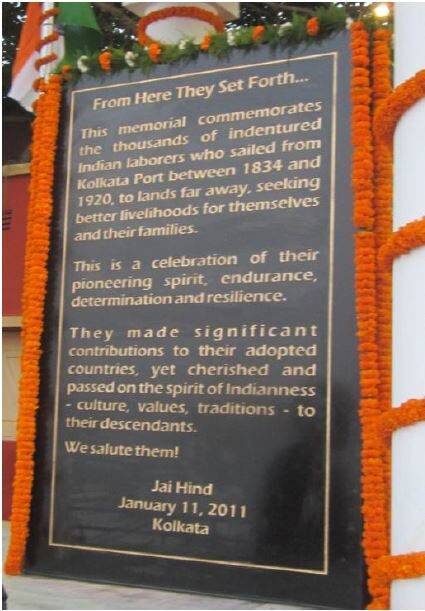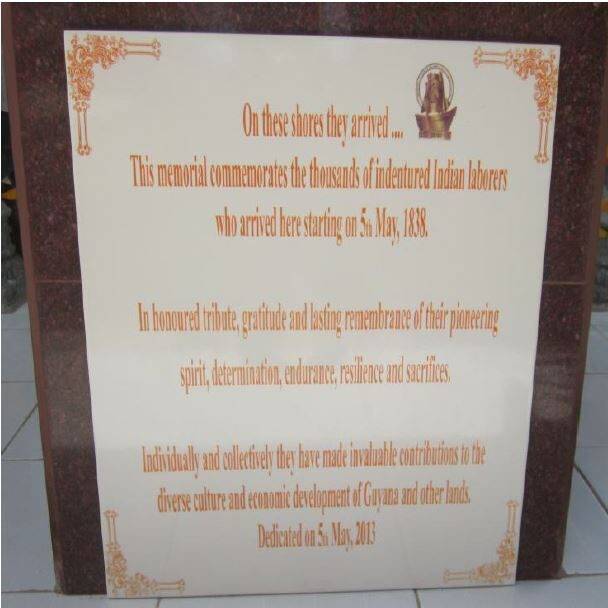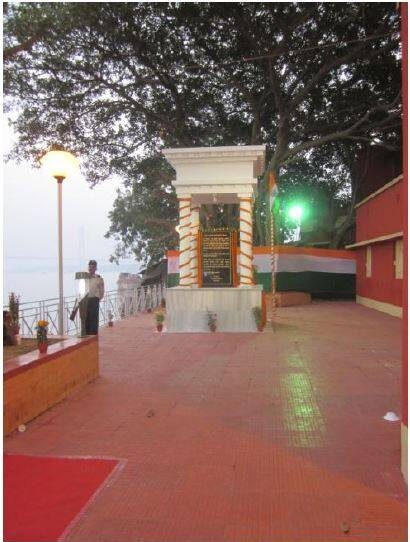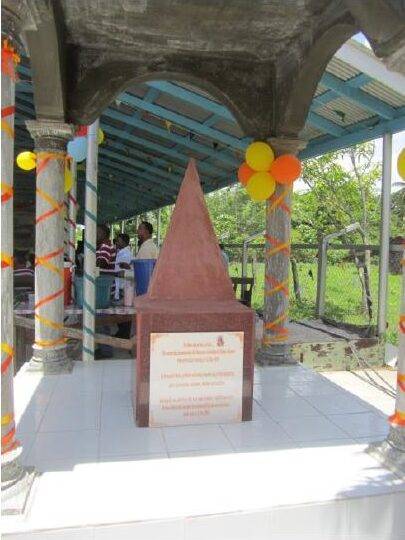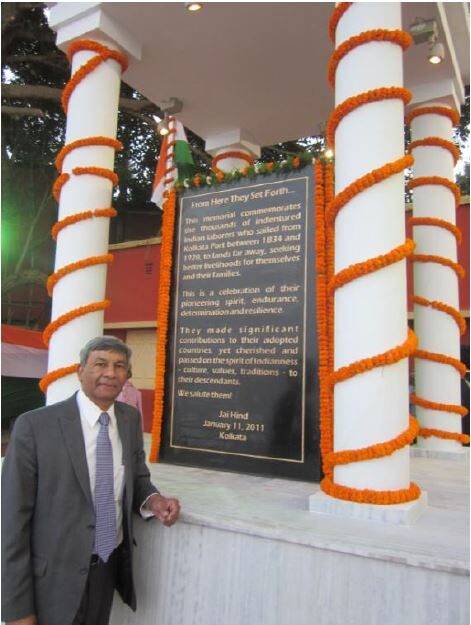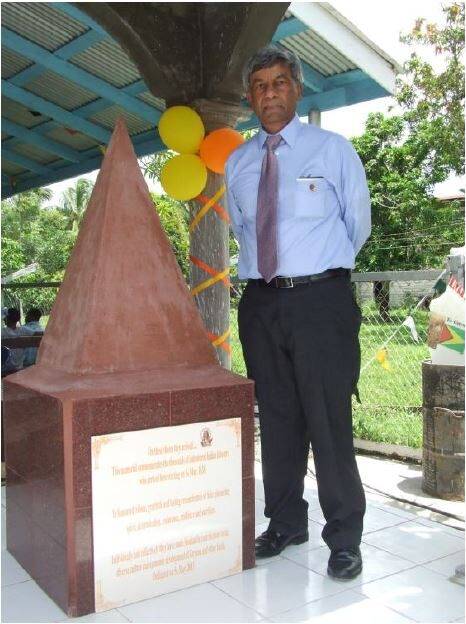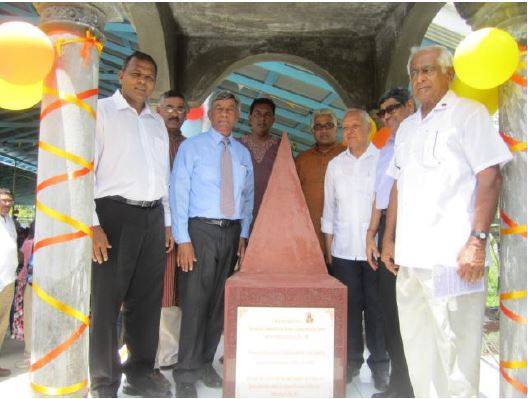










From Kolkata to Highbury (1838 – 2013): A Journey to Remember
By Ashook Ramsaran
Ancestral Footprints – 175th Anniversary of Immigration Celebration:
The Emancipation and Immigration of the Indian People in the Caribbean
Venue: York College, City University of New York
Date: May 18, 2013
Good afternoon everyone. Thank you, Dr. Mohamed Hack
All protocols observed.
I want to thank all the organizers for arranging this forum on 175th Anniversary of Indian Immigration Celebration: The emancipation and Immigration of the Indian People in the Caribbean
And for inviting me to share my thoughts among so many notable and qualified presenters.
The theme of my presentation today is:
From Kolkata to Highbury (1838 – 2013): A Journey to Remember
With emphasis on:
Our journeys – the footprints left for us, the footprints we leave and the footprints we are making; our obligation in documenting the journeys as duty and responsibility; monuments, markers and inscriptions; achievements; historical perspectives and the impact on history; preservation of culture and heritage; first and second migration trends.
There are many suitably qualified speakers here today who will provide in-depth details on their areas of study and expertise. I will try not to duplicate any of that.
Indian Heritage & Perspectives
Indian heritage and culture are the cornerstone of the diaspora, transcending time and place, surviving obstacles and severe situations, remoteness and influences. Despite speaking different languages, living in different and sometimes remote places, sustaining and improving our lives, we share heartfelt feelings of Indianness and the urge and yearning to connect and belong. Meanwhile, we have inherited and taken a lot from India and transformed our lives and the new countries of our birth or adoption.
The Indian diaspora is a continuing phenomenon and can be likened to “the export of people seeking better lives for themselves and their families” which we achieve, and subsequently we flourish after assimilation and adaption with each succeeding generation, while adding to economic progress of our respective countries of domicile. Indian heritage, culture and values are the driving elements for sustenance, survival, achievement, pride and progress at all levels.
Our diaspora is molded by culture, heritage and values while it also adds to and sometimes influences those traits in both subtle and visible ways: language, clothing, lifestyle, technology and social values.
The older diaspora, which I refer to as the legacy diaspora, of the Caribbean, Africa, Mauritius and Oceania, have retained more of the Indian culture and heritage intact and in its original form for the many reasons associated with remoteness, harsh living conditions, sense of belonging and togetherness, sustenance and bonding – while some adaptation was necessary, such as with foods and clothing, some conversion to Christianity, and break down of the caste system. Later, some Indian music and songs witnessed a fusion combination such as “Caribbean Chutney”.
It seems that wherever we Indians go, we take certain staples that sustain us: Mantra; Music; Massala; Memories; Mentoring; the importance of Mataji; the value of Money; and of course, thrift and hard work.
Simultaneously, we have a knack for reconciling our two (2) identities – our inherent Indianness and birth or newly adopted citizenship. We learn very easily to adapt, co-exist and progress in other countries with multi-ethnic societies far away from India or the Caribbean. Indian heritage is such a powerful asset in the diaspora that some colonial powers marginalized persons of Indian origin curbing cultural observances and by making it difficult to maintain cultural traditions. Despite such efforts, those Indians persevered and sought more to preserve and protect Indian by culture, heritage and values, and survived and remained vibrant.
I want to stress that adherence to heritage and cultural origin should not – and must not – diminish national loyalty. In fact, assimilation and adaption are key attributes to progressive lives in other birth or newly adopted countries.
Our heritage includes “blessings as well as yokes of burdens”. These are topics for extensive discussion.
With innovation, modern communications, advanced transportation and increased levels of mobility, as well as increased opportunities in other countries, there is re-migration or second journeys. There also some repatriation to the Caribbean countries after retirement.
Especially among older (legacy) diaspora, there is the yearning to find one’s roots with research and regular trips by PIOs from Caribbean, South Africa and Mauritius to find’s family and “roots”. The “Tracing our Roots” was first discussed at a session I organized at PBD20005 in Mumbai because of the need. The Kolkata Memorial, a diaspora initiative that I worked closely with Government of India to dedicate, is a beacon of acknowledgement of those who left India as indentured laborers from 1834-1920.
One must acknowledge and be grateful for the indisputable and invaluable role of civic, cultural, religious and advocacy organizations in preservation of inherent culture and values – such as GOPIO of which I am privileged to be the current president. These have helped promote assimilation with ease, generally peaceful co-existence among multi-ethnic societies. GOPIO is a non-political, secular global Indian diaspora advocacy organization addressing the concerns and interests of the global Indian community.
Indian heritage has undoubtedly influenced our lives and in time, we have also influenced the lives of others (non-Indians) in our midst. Visible examples include: Gadar movement spawned and encouraged others in diaspora countries in their struggle for their independence; Gandhi as model of tolerance and perseverance for those seeking peace, civil rights and equality in USA, South Africa and other countries; celebration and general acceptance of Holi and Diwali by non-Indians.
Courage, reliance, determination, thrift and hard work, competitiveness, faith reverence and respect – hallmarks of Indianness derived from culture, heritage and values that are maintained, nurtured and remain with us beyond the shores of India and the Caribbean.
Footprints
Our ancestors arrived barefoot from India to the Caribbean – just like Africans who were made slaves. It is ironic that we should talk about footprints because they physically footprints on the landscape as well. They have made a lasting impact on the lives of people and the countries where they lived: Socially, culturally, economically and politically. We came for opportunity seeking better lives. We came seeking better lives and we achieved beyond expectations.
The 1st journey 1838-1971 was charted for us by others with little or no choice of destination – a form of servitude. The 2nd journey is for opportunity by choice and circumstances. On this 2nd journey, we are designing the road map and leaving footprints along the way. Our second migration from Caribbean to North America and other countries are also part of the journey and impact on our lives and the lives of our descendants.
Our footprints are indelible and last forever – because of the historical significance of our journeys, because we make an earnest effort to make sure the steps, the journeys and experiences are fully documented regardless of moments of dispute or controversy or even unsavory episodes. We have progressed and will continue to make an impact wherever we go or whatever we do – with more footprints along the way. These are footprints that cannot be denied, diminished, disregarded or neglected.
Documenting the journeys
We must recognize those whose efforts contribute to tracing the foorsteps, follow the footprints and documenting the journeys. These include our many historians, researchers and writers, singers, including poets – among the known ones: Peter Rohuman, Dwarka Nath, Badseo Mangru, V. S. Naipaul, Balkrishna Naipual, Dhanpaul Narine, Baytoram Ramharack, Tyran Ramnarine, Clem Seecharran, Lakshmi Persaud and so many others then – now and to follow. It is important that we encourage more to do research and document this amazing phenomenon.
Efforts must be made to include Caribbean migration history in the schools where our people reside in USA and Canada – for this and the next generation to become more aware while education others about our history to crease more understanding among people of different backgrounds and ethnicity. We should also remember and recognize those who were the pioneers in the struggle for rights and freedom from colonial domination. There are many who are living as well as those who have passed on.


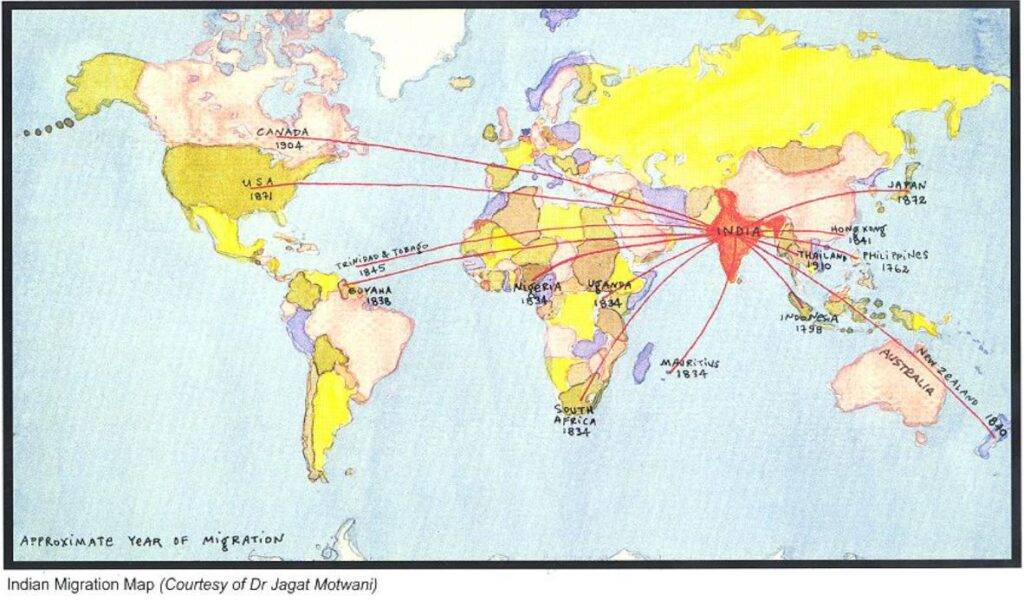
Migration of Indians to the Caribbean Region
Many from inland regions over a thousand kilometers from seaports were promised jobs, were not told the work they were being hired for, or that they would leave their homeland and communities. They were hustled aboard the waiting ships, unprepared for the long and arduous four-month sea journey. Charles Anderson, a special magistrate investigating these sugarcane plantations, wrote to the British Colonial Secretary declaring that with few exceptions, the indentured labourers are treated with great and unjust severity; plantation owners enforced work in sugarcane farms so harshly, that the decaying remains of immigrants were frequently discovered in sugarcane fields. If labourers protested and refused to work, they were not paid or fed: they simply starved.
The sugarcane plantation-driven migrations led to ethnically significant presence of Indians in Caribbean. In some islands and countries, these Indo-Caribbean migrants now constitute a significant proportion of the population. Sugarcane plantations and citizens of Indian origin continue to thrive in countries such as Guyana, formerly British Guiana, Jamaica, Trinidad, Martinique, French Guiana, Guadeloupe, Grenada, St Lucia, St Vincent, St Kitts, St Croix, Suriname and Nevis.
By some estimates, over 2.5 million people in the Caribbean are of Indian origin. Many have ethnically blended with migrants from other parts of the world, creating a unique syncretic culture.
Not just British colonies, sugarcane production affected human history in colonies controlled by other pre-World War II powers. France, for example, negotiated with Britain leading to Act XLVI of 1860, whereby large numbers of Indian indentured labourers were brought for harsh sugarcane plantation work in French colonies in the Caribbean region. The Caribbean colonies of the Netherlands too benefitted from the indentured laborers from India.
In recent years, attempts to commemorate the Indian presence and contributions have come to fruition: In 1995, Jamaica started to celebrate the arrival of Indians in Old Harbour Bay, St. Catherine Parish on May 13. In 2003, Martinique celebrated the 150th anniversary of Indian arrival. Guadeloupe did the same in 2004. These celebrations were not the fact of just the Indian minority, but the official recognition by the French and local authorities of their integration and their wide-scale contributions in various fields from Agriculture to Education, Politics and to the diversification of the culture of the Creole peoples. Thus, the noted participation of the whole multi-ethnic population of the two islands were in these events.
St. Lucia and many Caribbean countries have dedicated commemorative days to acknowledge the arrival and important contributions of their Indo-Caribbean populations. St. Lucia celebrates it Indo-Caribbean heritage on May 6. Other dates when the India Arrival Day is celebrated in the Caribbean include May 5 (Guyana), May 10 (Jamaica), May 30 (Trinidad and Tobago), June 1 (St. Vincent), and June 5 (Suriname).

Achievements
For a region with slightly over 1 million people of Indian origin, we have made tremendous strides and remarkable achievements while overcoming many hardships and obstacles. We have produced prime ministers, presidents, cabinet ministers, the best cricketers, Nobel laureate, legal minds, professions, entrepreneurs, scholars and scientists. These are stalwarts on whose shoulders we stand tall, who made it possible for us to be courageous and be recognized. They – and we – owe it all to those who made those first footprints.
Monuments & Inscriptions
I strongly believe in establishing markers as we make these journeys – markers which transcend time and place, cultures and creeds – markers for past, present and future – in recognition and remembrance of our journeys.
I am honored to have collaborated with the Government of India for the construction and dedication of the Kolkata Memorial on the banks of the Hugli River at a place called Demerara Kidderpore Depot in Kolkata on January 11, 2011. The Kolkata Memorial has meaningful significance to millions of descendants of those who left India as indentured Indian laborers from 1834 thru’ 1920. I am honored to have written the inscription expressing the hopes and aspirations of those early pioneers and their descendants.
I stated in one my published articles in 2010 that, “Our ancestors who left those shores truly deserve their place in the annals of Indian history and the journeys of people of Indian origin in the Indian Diaspora. We should all be very proud of our ancestors who made the first journey that has become an integral part of our history as well. We certainly owe them a lasting tribute, recognition of their sacrifices and a truly worthy remembrance”.
Kolkata Memorial Inscription
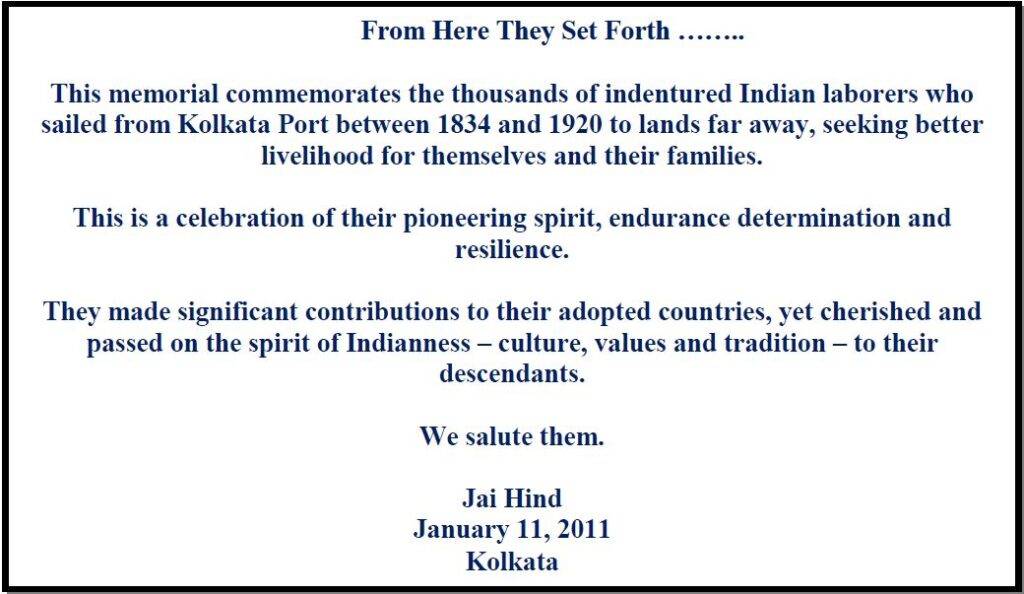
I again collaborated with the Government of India for support and funding for the construction and dedication of the Highbury Memorial commemorating the first arrival of Indians in Guyana on May 54, 1938 – in fact, the first indentured Indian laborer in the Western Hemisphere.
I am again honored to have written the inscription for the Guyana memorial monument expressing the hopes and aspirations of those early arrivals in Guyana and their descendants.
Guyana Indentured Indians Memorial Inscription
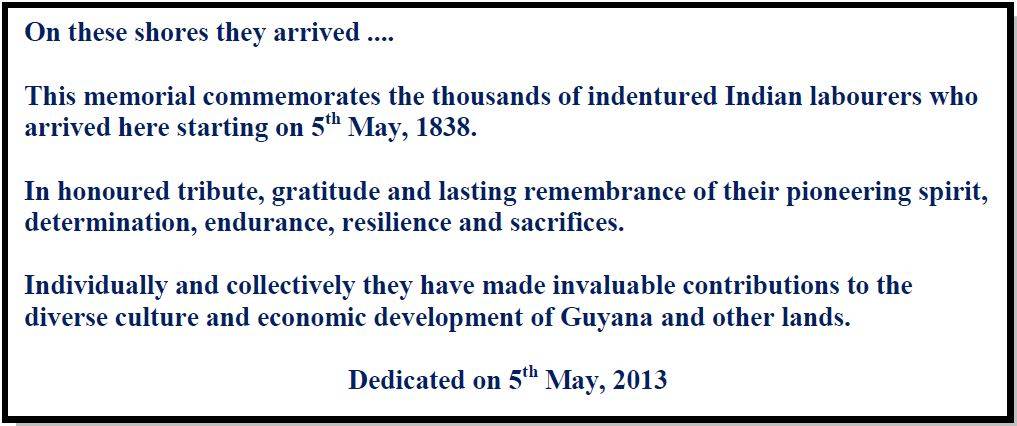
There was another similar memorial constructed at Monument Gardens in Georgetown.
When I unveiled each of these memorials on the same day – May 5, 2013 marking the 175th Anniversary of Indian Arrival in Guyana, I said (as I did on January 11, 2011 in Kolkata):
“While we dedicate this memorial, I am certain we are not alone. The souls of our ancestors are looking at us from above, smiling and saying “THANK YOU. YOU HAVE DONE WELL”. To which we would all reply: “THANK YOU FOR MAKING IT POSSIBLE”
Markers:
A few of the markers established and in process in Guyana:
- Highbury – Memorial Monument 2013
- Berbice – Monument to Indian Indenturedship – Sep 2013
- Berbice – Indian Cultural Center – 2014
- Monument Gardens – “We came in ships” replica
- Monument Gardens – Memorial Monument 2013
- Archives – Digitizing the archival records – begun May 2013
Planned Dialogue:
- 2014 GOPIO Conference in USA on “Preservation of Indian culture in the 21 Century
- 2014 GOPIO Conference in USA on “Peaceful Co-Existence of Indians in Multi-Culture Societies”
- Embrace and Engage: Assistance to Romani People in New York to organize and collaborate with Indo-Caribbean groups.
- 2014 GOPIO Conference in USA on “The Influence of Gandhi on the Civil Rights Movement in America”.
GOPIO has made a proposal for a plaque to be installed at a New York City park commemorating the arrivals and contributions of peoples of the Caribbean region to landscape of New York City in a very positive way.
While many tend to savor the past, we must be more assimilated, progressive, participatory and forward looking in countries where we are domiciled. The Hudson and St. Lawrence should be considered as the new Ganges.
Continuing
The dialogue continues as the Indian journey continues in so any progressive ways, adaptable to circumstances, conditions, time and place – with preservation of core values, heritage and history. Our pioneering spirit, resilience and determination are hallmarks of our journeys and will continue to sustain us as the journey continues.
Our history is being written by what we do and how our journey continues – and we leave more indelible and amazing footprints to remember and follow.
As a precaution: It behooves us to take all necessary steps to promote and preserve Culture, heritage and values among the younger generation in the diaspora with the influences of technology, mobility and inter-marriage — lest the diaspora wanes in these attributes that are serving it well.
Living outside of the Caribbean, we can teach a lot to others while we learn a lot as well. Living outside of the Caribbean, we have improved and transformed our lives and the countries where we live.
All diaspora are fortunate that nowadays there is freedom to migrate with many available countries which readily accept migration and becoming citizens, to make progress at all levels, to bring their extended families, to continue religious and cultural observances, and to live in safety.
I will conclude by saying:
This is an important conference and I thank the organizers. I am hopeful that this is a springboard to more in-depth discourse that this subject of first and second migration truly deserves – the why, where, when, who, what, influences, shape and form of the past, present and future – and the effects in a rapidly changing, dynamic and evolving diaspora. Our impact and changes to history as circumstances of history have brought us together – via migration, adaptation and assimilation. It is up to us to shape the future.
Thank you.
May 18, 2013
York College, New York
Ashook K. Ramsaran was born in Guyana, third generation of Indian indentured laborers who came to Guyana in 1853 and 1860 respectively. He emigrated to the USA in 1968 and obtained advanced degrees in engineering at Polytechnic University in New York. He is president of the Global Organization of People of Indian Origin (GOPIO International). He is founder and president of Ramex, an electronics manufacturing company based in New York, USA. He resides in New York, USA with his family. Contact: [email protected]



